Zoomer
I remember how in childhood mother told me that someday our Sun would go out and the Earth would die. I remember how sorry it was for people, and the assurances that it would be still very, very soon, sounded completely disappointing: after all, my distant descendants would live at that time! How so! They will die!
Many years later. Now I understand why it makes no sense to regret about their distant descendants, who can live to the end of the world. And this article is about that.
Perhaps you are aware of the existence of the Theory of Systems Development and of one of its laws, according to which all systems are developed on an S-shaped schedule, which can be conventionally represented as follows:
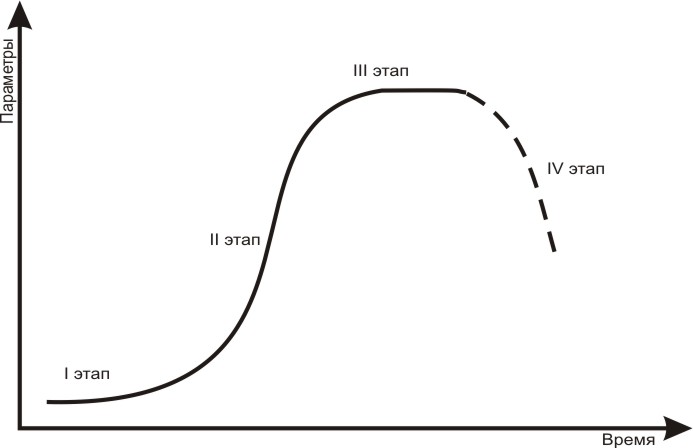
')
Vertically laid out the main parameters of the system, which can be used to assess its development, efficiency, etc. Horizontal - time, usually in years. The graph resembles the Latin letter S, hence the name "S-shaped curve."
In life, these S-shaped glasses are much more clumsy - elongated, flattened and stretched, but the general structure, all 4 stages, is repeated:
Stage I: the system begins its life and slowly develops over a long period of time (according to the schedule we see that for quite a long time the basic parameters of the system almost do not grow). If, in the role of a system, to imagine, for example, a person - then the first stage is childhood, which lasts quite a lot of years, but at this time we are doing little life achievement.
Stage II: the system has overcome the difficulties of the first stage and its rapid growth begins. For a person, this is youth and adulthood, a relatively abrupt transition from a child to a full-fledged member of society.
Stage III: the system is at the peak of its development in the main parameters, but at the same time it slows down and then completely stops its growth. For a man, this is maturity - he is full of strength, he has achieved a lot, but somewhere he rests on the ceiling, above which he is no longer able to jump.
Stage IV: old age, extinction, death. The value of the main parameters is reduced, the system ceases to meet the requirements of modernity, it accumulates contradictions that lead to its replacement by other systems. In the case of a person (and many other systems), death occurs. But some systems may exist in the latter stages for hundreds or even thousands of years - for example, state institutions, the army, the church.
The fact that everything ends up is rather sad, but not quite: as a rule, when the system is on its way to stage III (or switched to it), and already begins to feel oppression of contradictions, which prevents it from developing, to its base (or somewhere nearby) there is a new young system, which also begins its life from the first stage. For a person, this is the birth of a child who, as a rule, is somewhat better than his parents and can achieve something more in his life.
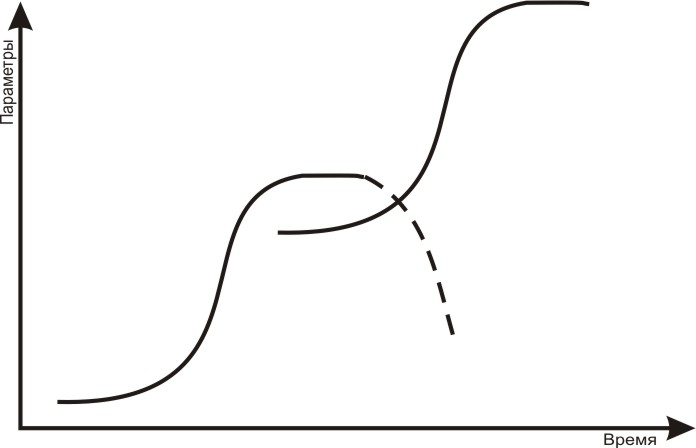
I used the human as an end-to-end example only for simplicity, in what follows we will talk about more global systems.
Let's take, for example, a certain abstract Internet project. Let a certain conditional Vasily do a social network in his hometown. At the first stage, he was happy for each new user, tried to respond to their needs and debug functionality, used his project himself and actively involved his friends and acquaintances in it. Vasya did all these efforts in the right direction, and this led to the fact that his project became popular - at some point the number of users began to grow exponentially, and within a few months of Vasin, the network gained ten times more users than in the entire past year. But, having existed for some time, the network fell into disrepair. Perhaps Vasya simply abandoned the project, he lived for some time by inertia, and then died. Or maybe Vasin's friend-developer Petya decided to make his own project (better and more functional than Vasin’s network) and lured the core of users there. Or maybe everyone just switched to Odnoklassniki and VKontakte. Well, such is selyavi, everything once comes to an end.
Let's now make a small Zoom Out and see what happened next to Vasin's project:
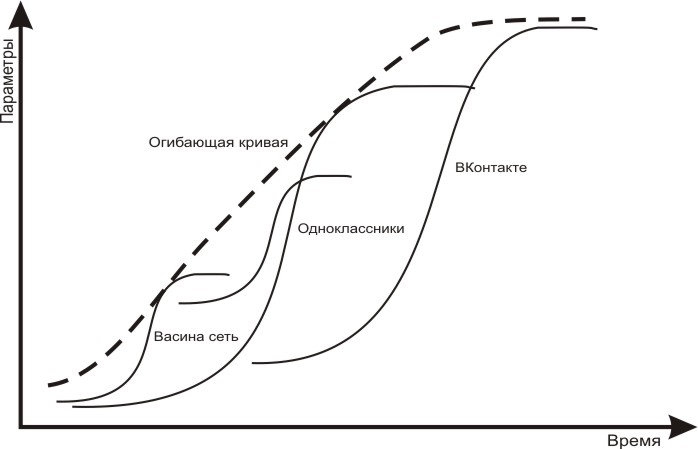
We see other social networks and networks that compete for a place in the sun with varying degrees of success. Above them is the so-called “envelope curve”, which shows the general development of this phenomenon, the super-system in which Vasin and competing systems develop. In our example, this is the “Social Networks” super-system.
If we take another reason, we will see that this whole supersystem is also developing on an S-shaped schedule: once it began its childhood in a world full of forums and home pages, and at first no one singled it out as a separate entity. But, gaining momentum, at some point it went into growth and became the main subject of conversation for the entire Internet world.
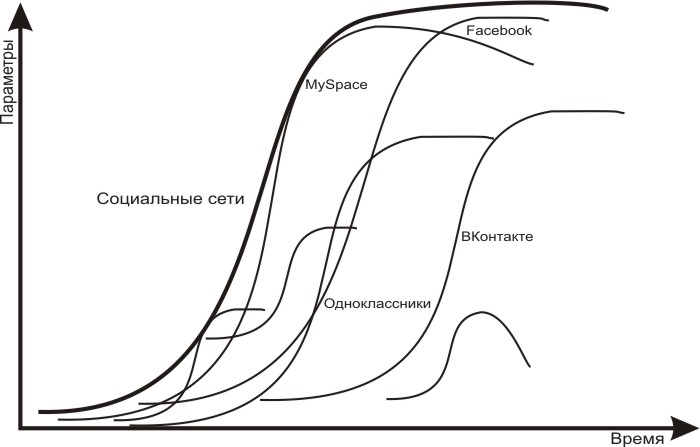
Yes, we all understand that over time, the Social Networks system also faces stagnation and death. But let's zoom further:
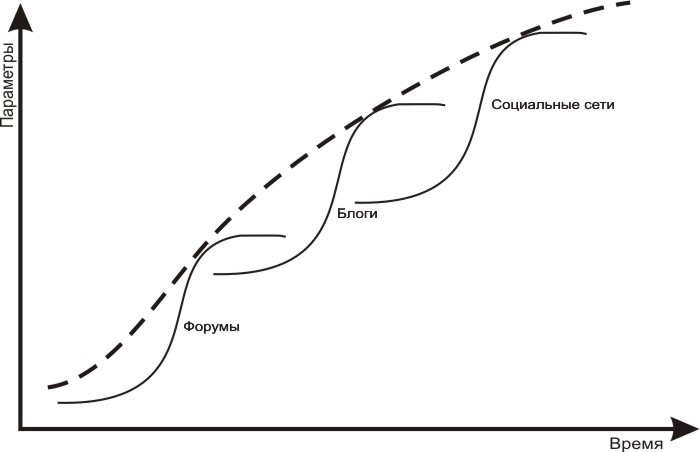
Next to social networks, there are other systems, each of which is at its own stage of development - someone is just gaining momentum, someone is already leaving the stage.
Already guessed that the envelope curve passes over these systems? That's right, this is our all-beloved Internet.
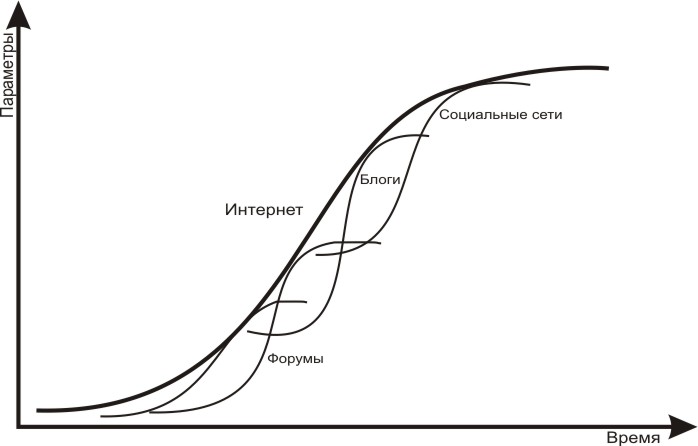
If you already want to throw rotten tomatoes into the author (after all, the Internet cannot die!) - believe me, they should be reserved for later, because the zoom continues:

There is deliberately not mentioned a system that will start “on the bones of the Internet” - fantasize yourself. For the seed, a little more theory: stopping the development of a system does not necessarily mean stopping its operation - often it enters as a part, a subsystem, into a newly created system. For example, e-mail as a standalone system ceased to develop many years ago, but it is successfully used by most modern Internet systems as a message delivery subsystem.
Well, let's zoom in next? What is this envelope curve connecting such different things as radio, television, Internet, and also robots, ships, airplanes and much more? This is nothing like the technical civilization that we are used to.

Such a thing turns out. Whatever one may say, it turns out that the end will come to her too (tomatoes flew, yeah).
You and I can even guess at what stage of our development the technical civilization is now, and we together with it. Technology has evolved all the time while a person lived (do we remember a stick-digging machine from school? Or is it no longer in history books?) However, for thousands of years the growth of technology went very smoothly - tools used by people tens of thousands of years ago are not so fundamentally different from those that they used a few centuries ago. Only in the second half of the XVIII century, with the invention of the steam engine and the beginning of the industrial revolution, the situation began to change radically. This marked the transition of the Technical civilization to the second stage of development of the S-shaped curve - after that, the growth of technology in all respects began to accelerate sharply.
XX century was the century of rapid development of technology. Living in the XXI-th, we seem to be seeing the continuation of this growth, although ... not everything is so rosy, there are also harbingers of future changes. Let us take, for example, the space program, which, with a locomotive, carried forward and upwardly many related industries, demanded the creation of new technologies and materials - where is it? What is the same "locomotive" came to replace her?
Against this background, the opinions of some scientists are not at all strange that science has stopped in its development , and after all, Science is the closest neighbor of Technique and they are developing side by side, only science a little earlier - it should create space for development for technology. And if science really stops, is it strange to talk about the upcoming end of the technical civilization?
What awaits humanity after the end of technical civilization? We can only guess. But if the assumptions of the founder of TRIZ, Heinrich Altshuller, are correct, and the unicellular development slowed down since nature "invented" the organism, and the development of organisms slowed down since society was "invented", then we can assume that the next S-type will express schedule for the development of social relationships in society.
It is difficult to imagine, although it is interesting to dream on this topic. By itself, it is worthy of a separate article, so I’ll just finish this note with a quote from the material that I definitely recommend reading:
“Now a lot of attention is paid to the problem of extraterrestrial civilizations. What are these, these foreign civilizations? Why aren't they looking for us and honking us? Why we do not see the manifestation of their activities?
Supercivilization is thought at the level of society, but only more developed, more energetically armed. But in fact, supercivilization should be a floor above, at the level of a super-community. Can an individual cell count on what it will specifically look for (to establish contact!) An organism?
Radio telescope projects, attempts to capture supercivilization signals, are spending more and more money and effort. Meanwhile, it is clear from the diagram that each floor is increasingly creating the conditions for the appearance of the next floor. Above-above-community floor should appear relatively quickly above the “society” floor, and then — even faster — the “super-community” floor should appear. Super-civilizations may be removed from us (on floors) further than a person is removed from elementary particles ... "
G.S. Altshuller. Creativity as an exact science. - M .: Owls. radio, 1979 . - p. 66-72.
Disclaimer:
Many years later. Now I understand why it makes no sense to regret about their distant descendants, who can live to the end of the world. And this article is about that.
Perhaps you are aware of the existence of the Theory of Systems Development and of one of its laws, according to which all systems are developed on an S-shaped schedule, which can be conventionally represented as follows:

')
Vertically laid out the main parameters of the system, which can be used to assess its development, efficiency, etc. Horizontal - time, usually in years. The graph resembles the Latin letter S, hence the name "S-shaped curve."
In life, these S-shaped glasses are much more clumsy - elongated, flattened and stretched, but the general structure, all 4 stages, is repeated:
Stage I: the system begins its life and slowly develops over a long period of time (according to the schedule we see that for quite a long time the basic parameters of the system almost do not grow). If, in the role of a system, to imagine, for example, a person - then the first stage is childhood, which lasts quite a lot of years, but at this time we are doing little life achievement.
Stage II: the system has overcome the difficulties of the first stage and its rapid growth begins. For a person, this is youth and adulthood, a relatively abrupt transition from a child to a full-fledged member of society.
Stage III: the system is at the peak of its development in the main parameters, but at the same time it slows down and then completely stops its growth. For a man, this is maturity - he is full of strength, he has achieved a lot, but somewhere he rests on the ceiling, above which he is no longer able to jump.
Stage IV: old age, extinction, death. The value of the main parameters is reduced, the system ceases to meet the requirements of modernity, it accumulates contradictions that lead to its replacement by other systems. In the case of a person (and many other systems), death occurs. But some systems may exist in the latter stages for hundreds or even thousands of years - for example, state institutions, the army, the church.
The fact that everything ends up is rather sad, but not quite: as a rule, when the system is on its way to stage III (or switched to it), and already begins to feel oppression of contradictions, which prevents it from developing, to its base (or somewhere nearby) there is a new young system, which also begins its life from the first stage. For a person, this is the birth of a child who, as a rule, is somewhat better than his parents and can achieve something more in his life.

I used the human as an end-to-end example only for simplicity, in what follows we will talk about more global systems.
Let's take, for example, a certain abstract Internet project. Let a certain conditional Vasily do a social network in his hometown. At the first stage, he was happy for each new user, tried to respond to their needs and debug functionality, used his project himself and actively involved his friends and acquaintances in it. Vasya did all these efforts in the right direction, and this led to the fact that his project became popular - at some point the number of users began to grow exponentially, and within a few months of Vasin, the network gained ten times more users than in the entire past year. But, having existed for some time, the network fell into disrepair. Perhaps Vasya simply abandoned the project, he lived for some time by inertia, and then died. Or maybe Vasin's friend-developer Petya decided to make his own project (better and more functional than Vasin’s network) and lured the core of users there. Or maybe everyone just switched to Odnoklassniki and VKontakte. Well, such is selyavi, everything once comes to an end.
Let's now make a small Zoom Out and see what happened next to Vasin's project:

We see other social networks and networks that compete for a place in the sun with varying degrees of success. Above them is the so-called “envelope curve”, which shows the general development of this phenomenon, the super-system in which Vasin and competing systems develop. In our example, this is the “Social Networks” super-system.
If we take another reason, we will see that this whole supersystem is also developing on an S-shaped schedule: once it began its childhood in a world full of forums and home pages, and at first no one singled it out as a separate entity. But, gaining momentum, at some point it went into growth and became the main subject of conversation for the entire Internet world.

Yes, we all understand that over time, the Social Networks system also faces stagnation and death. But let's zoom further:

Next to social networks, there are other systems, each of which is at its own stage of development - someone is just gaining momentum, someone is already leaving the stage.
Already guessed that the envelope curve passes over these systems? That's right, this is our all-beloved Internet.

If you already want to throw rotten tomatoes into the author (after all, the Internet cannot die!) - believe me, they should be reserved for later, because the zoom continues:

There is deliberately not mentioned a system that will start “on the bones of the Internet” - fantasize yourself. For the seed, a little more theory: stopping the development of a system does not necessarily mean stopping its operation - often it enters as a part, a subsystem, into a newly created system. For example, e-mail as a standalone system ceased to develop many years ago, but it is successfully used by most modern Internet systems as a message delivery subsystem.
Well, let's zoom in next? What is this envelope curve connecting such different things as radio, television, Internet, and also robots, ships, airplanes and much more? This is nothing like the technical civilization that we are used to.

Such a thing turns out. Whatever one may say, it turns out that the end will come to her too (tomatoes flew, yeah).
You and I can even guess at what stage of our development the technical civilization is now, and we together with it. Technology has evolved all the time while a person lived (do we remember a stick-digging machine from school? Or is it no longer in history books?) However, for thousands of years the growth of technology went very smoothly - tools used by people tens of thousands of years ago are not so fundamentally different from those that they used a few centuries ago. Only in the second half of the XVIII century, with the invention of the steam engine and the beginning of the industrial revolution, the situation began to change radically. This marked the transition of the Technical civilization to the second stage of development of the S-shaped curve - after that, the growth of technology in all respects began to accelerate sharply.
XX century was the century of rapid development of technology. Living in the XXI-th, we seem to be seeing the continuation of this growth, although ... not everything is so rosy, there are also harbingers of future changes. Let us take, for example, the space program, which, with a locomotive, carried forward and upwardly many related industries, demanded the creation of new technologies and materials - where is it? What is the same "locomotive" came to replace her?
Against this background, the opinions of some scientists are not at all strange that science has stopped in its development , and after all, Science is the closest neighbor of Technique and they are developing side by side, only science a little earlier - it should create space for development for technology. And if science really stops, is it strange to talk about the upcoming end of the technical civilization?
What awaits humanity after the end of technical civilization? We can only guess. But if the assumptions of the founder of TRIZ, Heinrich Altshuller, are correct, and the unicellular development slowed down since nature "invented" the organism, and the development of organisms slowed down since society was "invented", then we can assume that the next S-type will express schedule for the development of social relationships in society.
It is difficult to imagine, although it is interesting to dream on this topic. By itself, it is worthy of a separate article, so I’ll just finish this note with a quote from the material that I definitely recommend reading:
“Now a lot of attention is paid to the problem of extraterrestrial civilizations. What are these, these foreign civilizations? Why aren't they looking for us and honking us? Why we do not see the manifestation of their activities?
Supercivilization is thought at the level of society, but only more developed, more energetically armed. But in fact, supercivilization should be a floor above, at the level of a super-community. Can an individual cell count on what it will specifically look for (to establish contact!) An organism?
Radio telescope projects, attempts to capture supercivilization signals, are spending more and more money and effort. Meanwhile, it is clear from the diagram that each floor is increasingly creating the conditions for the appearance of the next floor. Above-above-community floor should appear relatively quickly above the “society” floor, and then — even faster — the “super-community” floor should appear. Super-civilizations may be removed from us (on floors) further than a person is removed from elementary particles ... "
G.S. Altshuller. Creativity as an exact science. - M .: Owls. radio, 1979 . - p. 66-72.
Disclaimer:
1. I apologize in advance for the conscious spaces and simplifications that I have allowed when writing this article. It is designed specifically to make it more accessible and at the same time fit in a reasonable volume.
2. Yes, I know - the pictures are terrible. But there were no ready ones, I had to sit down at Korel and put on my own.
3. All curves shown in the graphs are purely illustrative and not based on actual data.
Source: https://habr.com/ru/post/59355/
All Articles